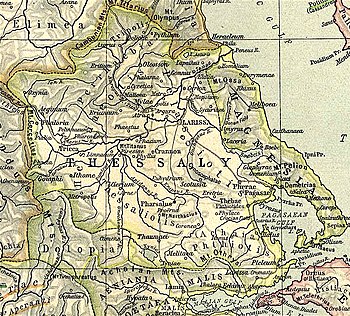39°11′25″N 23°13′03″E / 39.19027°N 23.21758°E

Spalathra ( Ancient Greek: Σπάλαθρα) [1] or Spalauthra (Σπάλαυθρα), [2] also called Spalethre (Σπαλέθρη) [3] and Spalathron (Σπάλαθρον), [3] was a town and polis (city-state) [4] of Magnesia, in ancient Thessaly, upon the Pagasetic Gulf. It is conjectured that this town is meant by Lycophron, [5] who describes Prothous, the leader of the Magnetes in the Iliad, as ὁ ἐκ Παλαύθρων (Σπαλαύθρων). [6] The town is also mentioned in the Periplus of Pseudo-Scylax as a city in Magnesia, together with Iolcus, Coracae, Methone and Olizon. [7]
The toponym is related to the Greek word "σπάλαθρον", meaning fire poker. [8] Perhaps from the shape of the peninsula on which it sat. [9]
Spalathra was located within the limits of modern Chorto. [10] [11]
- ^ Pliny. Naturalis Historia. Vol. 4.9.16.
- ^ Periplus of Pseudo-Scylax, p. 25.
- ^ a b Stephanus of Byzantium. Ethnica. Vol. sub voce Σπάλαθρον.
- ^ Mogens Herman Hansen & Thomas Heine Nielsen (2004). "Thessaly and Adjacent Regions". An inventory of archaic and classical poleis. New York: Oxford University Press. p. 721. ISBN 0-19-814099-1.
- ^ Lycophron, Alexandra 899.
-
^
 Smith, William, ed. (1854–1857). "Spalathra".
Dictionary of Greek and Roman Geography. London: John Murray.
Smith, William, ed. (1854–1857). "Spalathra".
Dictionary of Greek and Roman Geography. London: John Murray.
- ^ Periplus of Pseudo-Scylax, 65.
- ^ Jorge Martínez de Tejada Garaizábal, Instituciones, sociedad, religión y léxico de Tesalia de la antigüedad desde la época de la independencia hasta el fin de la edad antigua (siglos VIII AC-V DC), doctoral thesis, p.936. Madrid: Universidad Complutense de Madrid (2012). (in Spanish)
- ^ Lycophron, Alexandra.
- ^ Richard Talbert, ed. (2000). Barrington Atlas of the Greek and Roman World. Princeton University Press. p. 55, and directory notes accompanying. ISBN 978-0-691-03169-9.
- ^ Lund University. Digital Atlas of the Roman Empire.
![]() This article incorporates text from a publication now in the
public domain:
Smith, William, ed. (1854–1857). "Spalathra".
Dictionary of Greek and Roman Geography. London: John Murray.
This article incorporates text from a publication now in the
public domain:
Smith, William, ed. (1854–1857). "Spalathra".
Dictionary of Greek and Roman Geography. London: John Murray.
39°11′25″N 23°13′03″E / 39.19027°N 23.21758°E

Spalathra ( Ancient Greek: Σπάλαθρα) [1] or Spalauthra (Σπάλαυθρα), [2] also called Spalethre (Σπαλέθρη) [3] and Spalathron (Σπάλαθρον), [3] was a town and polis (city-state) [4] of Magnesia, in ancient Thessaly, upon the Pagasetic Gulf. It is conjectured that this town is meant by Lycophron, [5] who describes Prothous, the leader of the Magnetes in the Iliad, as ὁ ἐκ Παλαύθρων (Σπαλαύθρων). [6] The town is also mentioned in the Periplus of Pseudo-Scylax as a city in Magnesia, together with Iolcus, Coracae, Methone and Olizon. [7]
The toponym is related to the Greek word "σπάλαθρον", meaning fire poker. [8] Perhaps from the shape of the peninsula on which it sat. [9]
Spalathra was located within the limits of modern Chorto. [10] [11]
- ^ Pliny. Naturalis Historia. Vol. 4.9.16.
- ^ Periplus of Pseudo-Scylax, p. 25.
- ^ a b Stephanus of Byzantium. Ethnica. Vol. sub voce Σπάλαθρον.
- ^ Mogens Herman Hansen & Thomas Heine Nielsen (2004). "Thessaly and Adjacent Regions". An inventory of archaic and classical poleis. New York: Oxford University Press. p. 721. ISBN 0-19-814099-1.
- ^ Lycophron, Alexandra 899.
-
^
 Smith, William, ed. (1854–1857). "Spalathra".
Dictionary of Greek and Roman Geography. London: John Murray.
Smith, William, ed. (1854–1857). "Spalathra".
Dictionary of Greek and Roman Geography. London: John Murray.
- ^ Periplus of Pseudo-Scylax, 65.
- ^ Jorge Martínez de Tejada Garaizábal, Instituciones, sociedad, religión y léxico de Tesalia de la antigüedad desde la época de la independencia hasta el fin de la edad antigua (siglos VIII AC-V DC), doctoral thesis, p.936. Madrid: Universidad Complutense de Madrid (2012). (in Spanish)
- ^ Lycophron, Alexandra.
- ^ Richard Talbert, ed. (2000). Barrington Atlas of the Greek and Roman World. Princeton University Press. p. 55, and directory notes accompanying. ISBN 978-0-691-03169-9.
- ^ Lund University. Digital Atlas of the Roman Empire.
![]() This article incorporates text from a publication now in the
public domain:
Smith, William, ed. (1854–1857). "Spalathra".
Dictionary of Greek and Roman Geography. London: John Murray.
This article incorporates text from a publication now in the
public domain:
Smith, William, ed. (1854–1857). "Spalathra".
Dictionary of Greek and Roman Geography. London: John Murray.